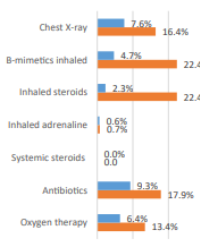
Bronchiolitis Management – Towards a Recommendation, Why We Bend the Rules?
Purpose : Guidelines adherence and identification factors influencing non-compliance with recommendations in bronchiolitis management.
Methods : A retrospective study of children hospitalized with bronchiolitis from December 1, 2014, to December 31, 2016. Infants aged under 24 months, with an episode of bronchiolitis, were included. Data was analyzed separately for children aged under 12 months with the first episode of dyspnea (strict bronchiolitis) and aged 12 up to 24 months or with the history of previous dyspnea (loose bronchiolitis). There were compared patients treated with the recommendations (adherent group) and not (non-adherent group).
Results: 306 infants were included. 253 patients (82.7%) were treated according to recommendations. 162 (94.2%) of the 172 meeting the “strict bronchiolitis” criteria and 91 (67.9%) of the 134 with “loose bronchiolitis”. In the non-adherent group (n=53, 17.3%) more patients were aged over 12 months (56.6% vs 24.1%), with risk factors (43.4% vs. 30%), previous episodes of bronchiolitis (41.5% vs 15.4%), higher respiratory rate (49 vs 44/min), greater need of oxygen therapy (32% vs 16.6%) and PICU transfer (5.7% vs 0.8%).
Conclusions : Children with bronchiolitis under the age of 12 months with the first episode of dyspnea are more likely to be treated in accordance with the guidelines. The use of additional drugs is due to older age, significant medical history and severe clinical symptoms.
Keywords: Bronchiolitis; Guidelines Compliance; Hospitalized Infants.
Henryk Szymański, Sara Szupieńko*, Maciej Ostrowski, Karolina Pietraszewska, Adrianna GórniakOktaba and Aleksandra Buczek


